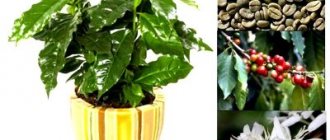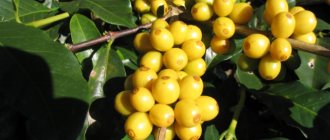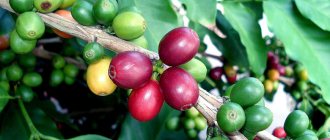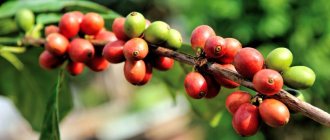General information
The foliage of the coffee tree is not small, fleshy and has a greenish tint. Flowering begins and the plant produces an umbrella-like inflorescence consisting of approximately 76 flowers.
The flowers are white on small roots and appear on young annual stems. The fruits of the plant consist of two seeds, round in shape, initially having a yellow tint, turning into green. And the ripe fruits of the coffee tree are red. When the fruit ripens, it is covered with a crust on the outside, and inside is filled with sweetish, slightly sour pulp and a pair of seeds about 13 mm in length.
Home-grown coffee trees have beneficial properties. It can purify the air from harmful substances, increase and improve a person’s energy capabilities, reduce and relieve stress and put the nervous system in order.
Main features and types of wood
The coffee tree is an evergreen crop from the Rubiaceae family, native to Ethiopia. It unites about 40 varieties.
Main Features of Coffee Tree:
- Under natural conditions, the height of the plant is 2.5-3 m. When growing a coffee tree at home, dwarf varieties up to 80-100 cm in height are used.
- The leaves are long, fleshy, with wavy edges, hanging down on thin shoots, dark green in color.
- During the flowering period, the tree is covered with snow-white flowers, formed in bunches of 15-20 flowers with small peduncles.
4.After flowering, green berries are formed, which turn red as they ripen. Each fruit consists of 2 grains.
5.The coffee tree blooms from April to September.
6.Ripe fruits up to 1-1.6 cm long are covered with a crust, the flesh is sweetish with a slight sourness.
Before planting coffee at home, you need to choose a tree variety. Most often, Arabian, Congolese or Liberian wood is used for this.
The Arabian variety is the well-known Arabica. In the wild, the plant reaches 4-6 m in height; at home, the “Nana” variety is grown, the height of which does not exceed 70-80 cm.
The Congolus variety or Robusta is distinguished by its fast growth and ease of care. A peculiarity of this species is the falling of fruit shoots with leaves after their natural death.
Liberian variety - characterized by tall growth and a massive root system. This tree is grown only in special greenhouses or large premises.
Arabica (Arabian coffee)
It is a low tree with oval leaves. The leaf blades have an olive tint. The flowers are very small. The fruits are burgundy.
Arabica is the most popular variety of coffee to grow indoors.
Liberian coffee
A tree with a thin trunk and large (30-40 cm) leaves. Unlike other varieties, Liberian coffee has leaf plates that are more rounded towards the end. Fruits abundantly. The berries are yellowish-red. It lends itself well to pruning and crown shaping.
Nana (Dwarf coffee)
A very beautiful small tree (up to 80 cm) with glossy leaves. Unlike other varieties of coffee, it bears fruit very well in an apartment. Has high decorative value. Loves being sprayed.
Types of coffee trees
The Arabian coffee variety , popular for growing at home, is a compact tree. The leaves are shaped like an elongated ellipse with a dark olive tint, glossy on the outside and pale on the inside. The inflorescences are small, about 2 centimeters in diameter, collected in a bouquet. The size of the inflorescences directly depends on the growing conditions.
Once opened, flowers remain fresh for only a few hours. But the buds gradually open, not all at once. After the inflorescences fade, the fruit ripens in the form of a berry; when ripe it has a burgundy hue. Ripening occurs approximately 8 months after pollination. The paired fruits resemble round beans. This species reaches a height of up to 5 meters.
Coffee dwarf Nana is a neat plant, reaching a height of about 85 cm. It blooms profusely and subsequently bears fruit well at home. The tree can be given the desired design by trimming and pinching the tops of the plant.
Liberian coffee is also grown indoors. Its ripe fruits have a scarlet or sunny slightly orange tint. The length of its leaves reaches up to 40 cm, and the height is adjusted and the required shape is formed by trimming the crown of the plant. The inflorescence has a light shade and large fruits - berries.
Growing a coffee tree
Next, we will tell you how to properly plant a coffee tree at home.
Those wishing to grow a coffee tree at home should take into account that young specimens grow best on windows located to the south. If there is insufficient light and heat, the tree may bloom, but will not bear fruit. When the temperature drops below +12°C, growth slows down and the root system rots.
Features of growing from grains
First, let's look at how a coffee tree propagates at home.
There is nothing complicated in the instructions on how to grow a coffee tree from seeds.
Experts emphasize that such a plant will not bloom and bear fruit in the first year.
A full-fledged tree from coffee beans grows 3-4 years after planting the seeds in the ground. Before planting seeds, you need to make sure that grains stored no more than 2 weeks after picking from the tree have good germination.
The earlier the seeds are collected, the less likely they are to be suitable for planting. When purchasing planting material, it is recommended to purchase twice the amount required for planting. Experts have found that the germination rate of coffee beans is about 10%.
Instructions for planting coffee beans:
- the seeds need to be peeled;
- place in a 2% solution of potassium permanganate;
- dry on a napkin, avoiding direct sunlight;
- plant in individual small containers with the flat side on the ground, 1 cm deep.
After the shoots grow to 7-10 cm and become stronger, they can be transplanted into larger pots. The soil for plants should consist of a drainage layer, a mixture of peat, leaf turf, river sand and garden soil. Some gardeners prefer to buy ready-made soil for indoor fruit plants.
Like all heat-loving plants, the coffee tree loves warmth and moderate humidity. To speed up germination, pots with plantings can be placed on the windowsill and covered with cling film.
Such improvised mini-greenhouses will improve the chances of seed survival. After this, daily ventilation is required. Watering is carried out by adding water to the trays once every 3 days.
Planting seedlings
Shoots usually appear after 1.5-2 months.
- As soon as the seedlings rise 2 cm from the ground, it is recommended to ventilate them 2-3 times more often.
- Within 30 days, the seedlings must completely get used to room temperature and the film cover is removed.
- After 2.5-3 months, a miniature coffee tree with 5 true leaves is formed. At this time, they need to be planted in individual flower pots.
Flowerpot and soil
When choosing the diameter of the container, you need to rely on the height of the plant. If it has reached 20 cm, you will need a flowerpot at least 15 cm wide. The third part of the container is filled with drainage (expanded clay, crushed crushed stone), the rest of the volume is filled with soil.
The best option for choosing materials for pots is clay or ceramics. In the first year of growth, the coffee tree requires additional air supply to the roots.
Rules for planting cuttings
Preparation of cuttings takes place mainly in the last ten days of February or the first week of March. The optimal rate of survival of cuttings is about 4 weeks.
The advantages of this method over planting grains are as follows:
- there is a high survival rate;
- With good care, fruiting occurs already in the first year;
- rapid growth contributes to the formation of large ovaries and a good harvest.
Cuttings for planting are taken only from shoots that have already bear fruit. Only the middle part, 3 cm away from the first leaves, is considered suitable. Excisions are made on the lower part of the cutting with a sharp knife to speed up the appearance of young roots.
Before planting in the ground, the prepared branches are placed in a root formation stimulator for 2-3 hours.
The soil for planting cuttings must match the composition in which the mother plant grows. It is necessary to bury the seedling in the ground until the first leaves. The pot is covered with film and subsequently removed daily for ventilation for 5-10 minutes. At the first stage of establishment, the plant is not watered, but sprayed.
Caring for a coffee tree at home
The plant does not tolerate drafts and temperature changes. With proper care, you will enjoy fresh homemade coffee all year long.
The coffee tree prefers abundant, diffused lighting. The optimal location would be the southern part of the room. Constant ventilation is required in winter and preferable cultivation on loggias or terraces in the warm season. During the heating season, it is necessary to place the plant away from the radiator to avoid drying out the tips of the leaves. If there is insufficient lighting, it is necessary to use an artificial lamp.
The air temperature for the plant in summer should not exceed 25 degrees, and in winter it should not drop below 15 degrees. If you do not comply with the temperature conditions, the plant may lose its leaves and drop its buds.
The plant prefers regular spraying, and in the summer the plant needs to have a warm shower, this helps well with growth and active flowering. The humidity in the room should be high.
Watering in the summer is regular, allowing only one centimeter of the soil layer to dry, and in winter it should be reduced by one centimeter per week. Water for irrigation should be soft and settled, free of limescale, otherwise the plant may begin to hurt.
Preparing the soil for cultivation
Coffee loves acidic soils, which corresponds to the conditions of its homeland. The pH level for coffee should be between 4.5 and 5.5. At the same time, some gardeners recommend using soils for azaleas, hydrangeas or rhododendrons for coffee trees at home.
However, you should pay attention to the acidity level
If it is slightly higher than recommended (for example, soil pH for azaleas is 4.0), it can be used to grow a coffee tree, but if the soil is highly acidic (pH = 3.5), then it is better not to do this.
Fruiting coffee tree (Arabica), grown at home
Sometimes inexperienced gardeners purchase soil suitable for growing citrus fruits for a coffee tree. It is only partially suitable for the coffee tree, since its composition is acceptable, but it is more neutral than slightly acidic. You also need to know that approximately six months to a year after the start of active growing season, the soil under the coffee tree changes its composition and ceases to be acidic, shifting to neutral acidity.
In both of the considered cases, to ensure a normal acidity level for coffee, it is recommended to “acidify” the soil once a month. This is best done with lemon juice in a concentration of 3-4 drops per 1 liter of water. If you don’t have lemon on hand, you can use citric acid (2-3 grains per 1 liter of water).
The roots of the coffee tree are quite long, penetrating deeply into the soil. To ensure they have adequate supply of nutrients and air, it is necessary to use well-drained and loose compounds. The matted soil must be loosened and humus or peat added to it (depending on the acidity).
You can prepare the soil yourself. For this you will need:
- turf soil – 1 part
- leaf soil - 1 part
- humus - 1 part
- coarse river sand – 1 part
- peat – 2 parts
Sometimes it is recommended to add 0.5 parts of sphagnum moss to this composition for greater looseness.
Projects of country houses for 6-10 acres: 120 photos, description and requirements | The most interesting ideas
Coffee tree diseases at home
- Why do the leaves of a coffee tree dry out ? The reason may be low humidity in the room and dry air. It is necessary to increase spraying and watering.
- Parasites can also attack the coffee tree, such as sooty fungus, scale and mealybug . Cobwebs and a white coating appear on the plant. You can get rid of them using a soap solution, after first destroying the infected leaves.
- Why do the leaves of the coffee tree turn yellow and begin to discolor . The reason for this is insufficient soil acidity.
- Why do the leaves of a coffee tree fall off and brown spots appear ? This indicates a lack of soil moisture.
- Necrosis of coffee tree leaves - occurs as a result of a lack of phosphorus and potassium, lack of light or dry air in the room. A sudden change in temperature in the room may also be the cause. With insufficient phosphorus fertilization, the plant slows down in development and leads to yellowing and falling leaves.
Difficulties in growing a coffee tree at home
Coffee is unpretentious, but sometimes problems arise when growing it, which are reflected in the foliage. From waterlogging, especially during cold periods, coffee leaves:
- turn black;
- fall off prematurely;
- young leaves turn yellow.
Moisture deficiency also negatively affects the condition of coffee. The leaves droop and become lethargic. The first signs of insufficient air humidity are the curling of leaf plates and the appearance of dry stripes along the edges.
Darkened, flabby edges of leaves occur from excess light. Complete darkening indicates low soil acidity. From a draft, the leaves become covered with black spots, and when there is a phosphorus deficiency, they become purple.
An indoor coffee tree will decorate the interior with glossy emerald foliage; When it blooms, it will fill the house with a fragrant aroma. With careful attention and proper care, an exotic seedling will definitely produce fruits from which you can brew a wonderful drink.
Temperature and lighting
The coffee tree grows well at home in spring and summer in room climate conditions (+22-+25C), and in winter it needs cooler conditions - +15C. If the temperature “column” drops below +12C, then the tropical crop sheds its foliage and buds. Drafts and sudden temperature changes negatively affect the plant.
It is advisable to place a coffee tree at home on windows facing south and southwest. You can also place it on the north side, but growth will slow down. Excess sun is harmful when the tree is less than two years old and after fruit has set. During these periods it should be shaded.
It is more difficult to create the necessary lighting in the autumn-winter period, in cloudy weather. Typically, additional illumination mode is used with a fluorescent lamp.
Planting a coffee tree
To plant a tree that will bear fruit in the future, you need to take this process as seriously as possible.
There are 2 methods of planting it:
- Grain;
- With a cutting.
How to plant a coffee tree using beans or seeds?
You can buy coffee beans in a store, or you can get them from friends or relatives. Just don’t confuse it with roasted coffee beans. The method of planting using grain is the most difficult. Although not much different from planting a lemon or pomegranate. But there are distinctive features. The reason for the difficulty when planting coffee seeds is its structure, namely a very hard and durable shell. Its rigidity often interferes with seed germination.
In this regard, before planting a seed in the ground, it is necessary to scarify it. What is scarification? This is the destruction of the seed shell.
It can be carried out using two methods:
- Chemical (solution of sulfuric or hydrochloric acid);
- Mechanical (incision or filing of the seed);
After this procedure, it is important to soak the grain in one of the stimulating solutions such as “Zircon”, “Kornevin” or some other. It is important to plant the grain in soil that is soft enough
It cannot be buried deeply; it is enough to simply lay them on the ground without sprinkling soil on top. Plant the seeds at a short distance from each other, if there are several of them - about 4 cm. Plant the grain in the ground with its flat side down, and its convex side up, respectively.
How to plant a coffee tree using cuttings?
Coffee tree cuttings
If you manage to get a cutting of a coffee crop somewhere, then that’s just great. In this case, it will begin to bear fruit much faster. It will be possible to collect the first fruits already in the first year of growth of this crop.
Since the cuttings retain all the properties of the mother plants, they will produce large fruits and in large quantities. However, the growth of the tree itself is slower than when planted as a seed.
In addition, the coffee will not grow in height, as if it were planted as a grain, but in width. It is very easy to plant; there are no differences from planting other crops using cuttings.
Growing by cuttings
You can grow a coffee tree from a cutting in a shorter time compared to the seed method.
But this option for propagating a coffee tree is not without its drawbacks. First of all, the need to form a crown, which should be done almost as soon as the plant begins to grow.
If you grow coffee by seed, even with an extremely low percentage of germination, from green seeds purchased in a store, then in order to grow a coffee tree from a cutting, you need to have a mother plant from which the shoot is taken.
Separation from an adult plant and planting of the cuttings are carried out in the following sequence.
- Using a sharp knife, a branch is separated from the mother plant, which should have two pairs of leaves.
- At the cut site, with a thin needle, the bark is excised along the trunk.
- The end of the branch where the cut was made is soaked in any growth activator for 12 hours.
- The cuttings are planted in a container with soil, 10 cm in diameter, watered with warm water, and placed for round-the-clock supplementary lighting at an ambient temperature of +25 degrees.
- When the cutting is fully accepted, it is necessary to transplant it into a larger pot.
When growing a coffee tree in this way, the plant can bloom already in the first year of life, and starting from 3-4 years old, produce a stable harvest of fruits twice a year.











